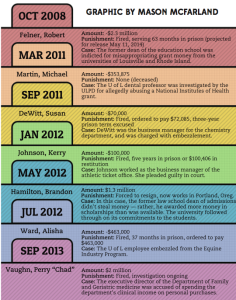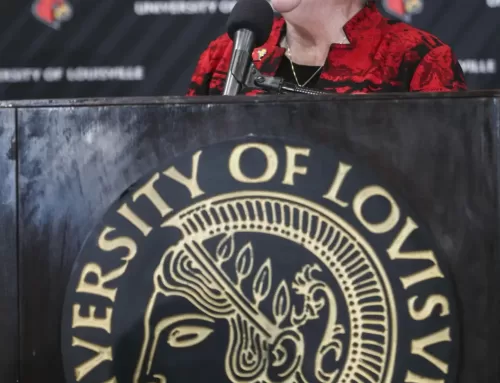By Simon Isham —
The recent embezzlement case at U of L, in which Perry “Chad” Vaughn was accused of stealing $2 million from the Department of Family and Geriatric Medicine, has raised questions about how the university deals with fraud cases, how it plans to prevent fraud and whether this case will have any immediate or lasting consequences for the university budget.
University President James Ramsey told the Cardinal that he did not believe that Vaughn’s actions would jeopardize the university’s receipt of any current or future grants, as the funds were not university property. He also said he did not believe the National Institutes of Health, from which U of L receives multi-million dollar grants, would be concerned about the university’s controls in this instance.
Furthermore, Ramsey said that he believes that all or most of the funds will be reimbursed by the university’s insurance, with claims filed on behalf of the Department of Family and Geriatric Medicine.
The university has three different coverage policies from KSBIT, AIG and Chubb. AIG, the newest insurer, will cover theft losses that occurred after July 1 of this year. KSBIT will reimburse losses that occurred prior to that, but U of L’s coverage has a limit of $100,000. The rest of the money will be sought through an additional claim to Chubb, which has a $2 million limit.
University spokesperson Mark Hebert said he believes all of Vaughn’s criminal activity took place before July 1. The investigation into this matter is ongoing.
According to the ULPD detective on the case, Jeff Jewell, Vaughn had been promoted into a position for which he was not qualified. The executive director job at the Family and Geriatric Medicine department required at least a master’s degree, but Vaughn only had a bachelors. He was hired into his position in 2008, before numerous changes in university Human Resources policy, which aimed to prevent lax hiring practices, were implemented in 2009.
Unlike past cases of fraud at U of L, the money that Vaughn embezzled was not from a university budget. Ramsey explained that U of L doctors are expected to supplement their work with either research or private practice, and that the accounts Vaughn siphoned from were from clinical accounts.
Because the funds in question were not university funds, they could not be audited like the rest of the university’s accounts. In Jan. 2012, the university moved to combat the possibility of fraud in the medical program by merging more than 100 sets of private financial records into a single account with central oversight. The Board of Trustees also approved the hiring of an external Certified Public Accountant firm to perform unannounced audits of every department in their last meeting.
Ramsey was first notified about Vaughn in Oct. 2012, when a faculty member received a comment from one of Vaughn’s colleagues about Vaughn’s seemingly lavish lifestyle. The faculty member sent Ramsey an email about the concern, and Ramsey turned the complaint over to the university’s internal auditors.
The auditors performed a limited audit on the gift account that affected the faculty member, and turned up nothing. It was only after the auditors performed a more complete audit on the entire Family and Geriatric Medicine budget that they learned what had happened.
The University of Louisville Police Department submitted a report to the United States Attorney’s office immediately upon finding solid evidence of a crime. The story became public after the U.S. Attorney’s office froze Vaughn’s accounts.
Hebert said that the university is not in control over when the details of such an investigation can be released to the media.
The university employs 6,901 faculty and staff, according to the most recent numbers. Of these, Ramsey said, “99.99 percent come to U of L every day and work hard and work diligently and are honest. We know that in our world there are some people who aren’t honest. The Kentucky prisons have 20,000 prisoners in them. There are people who are bad people, and who violate the public trust. Over a five or six or seven year period, with 6,000 employees, there have been six that have been identified … in every case, we have found them, we have fired them, we have gone public and we have prosecuted.”





